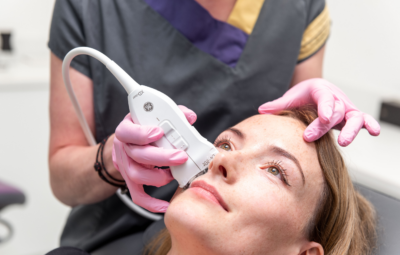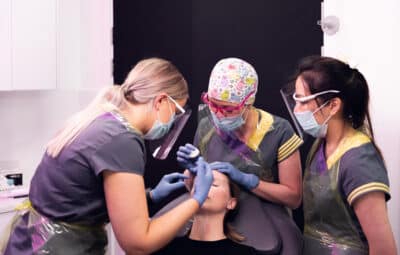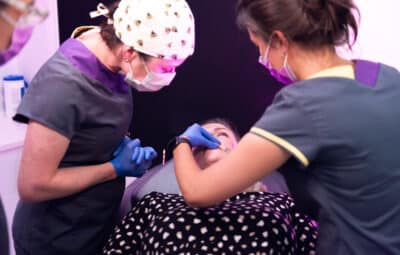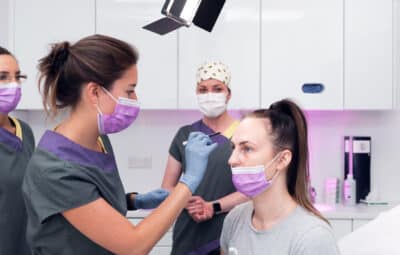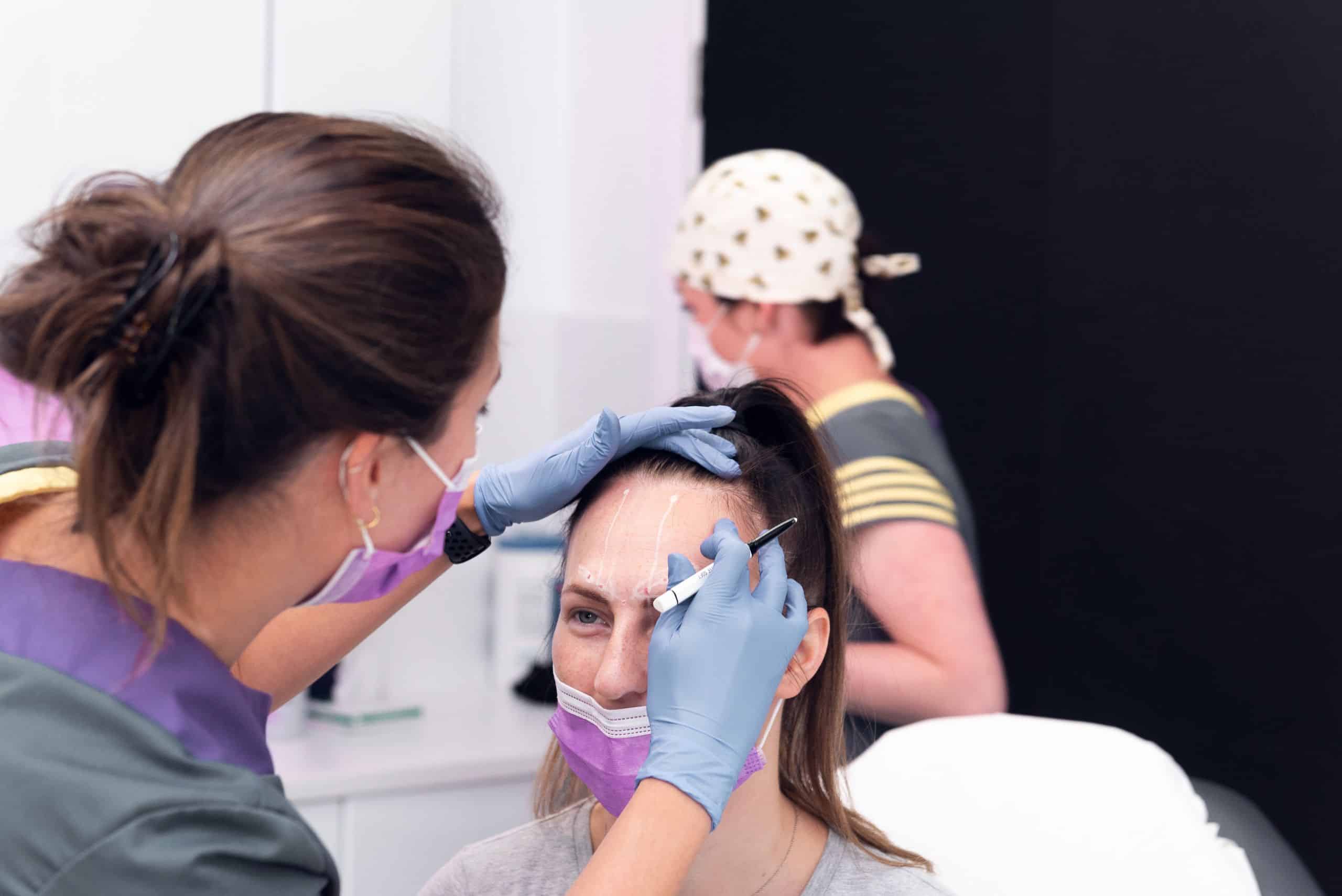
Master Botox Forehead Injection Sites: Expert Techniques
12 June 2025
In this post:
- Forehead Botox requires in-depth anatomical knowledge, especially of the frontalis muscle, to avoid complications like brow ptosis or unnatural results.
- Correct injection site placement and dosing (with attention to muscle bifurcation, safety margins, and patient risk levels) are crucial for effective and safe outcomes in both male and female patients.
- A tailored approach based on patient assessment (skin quality, brow position, asymmetries) ensures natural results and minimises complications, especially for high-risk patients or those with lid laxity.
The forehead remains one of the most popular areas for Botox, but it’s also one of the most dangerous to inject. While complications from forehead fillers gone wrong often get the spotlight, botulinum toxin injections carry their own set of risks too.
The frontalis muscle’s large size and complex anatomy demand precise technique and a thorough understanding to achieve the smooth, natural results your patients expect while avoiding the dreaded ‘frozen’ look, brow ptosis, or droopy eyelid botox.
Understanding the frontalis muscle and mastering the proper injection sites is a crucial skill for any injector serious about delivering exceptional results while maintaining patient safety. In this blog post, we’ll dive into all of this and more.
This blog post takes content from our renowned Botox course. With videos from expert injector and HUB founder Dr MJ Rowland-Warmann, this course is perfect for beginner injectors. Enrol today to watch the full video.
What is the Frontalis Muscle?
The frontalis is the large, flat muscle responsible for raising the eyebrows, spanning the entire forehead from the brows to the hairline. For Botox treatment purposes, we focus on the section between the brows and the hairline. This is the primary area that causes the horizontal forehead wrinkles that concern so many patients. Forehead lines are among the top concerns patients bring up at our aesthetics clinic Smileworks Liverpool.
When the frontalis contracts, it elevates the brows, creating that ‘surprised’ look and forming horizontal forehead lines. Our treatment goal is to reduce this wrinkling while maintaining natural brow position and movement.
Critical Anatomical Considerations
The frontalis bifurcates in approximately 80% of individuals at around 5cm above the orbital rim, creating two muscle bellies with a fibrous midline dehiscence. In patients with strong frontalis muscles, you can actually observe this midline zone of inactivity, making central toxin placement often pointless.
The muscle blends with the corrugator supercilii and orbicularis oculi fibres, requiring careful attention to safety margins to prevent unwanted diffusion into these areas.
Is Forehead Botox Safe?
With proper technique, forehead Botox is incredibly safe.
Before we discuss injection sites, understanding the safety margins is paramount. Botox diffuses approximately 1cm from the injection site, making precise placement crucial for maintaining areas of frontalis activity that prevent brow droop.
The key safety boundaries are:
- Lateral Border: The temporal fusion line marks the lateral frontalis border. Never inject beyond this easily palpable line.
- Inferior Border: Maintain at least 2cm above the brow to prevent diffusion into the corrugator supercilii and orbicularis oculi.
- Medical Consideration: Account for the natural bifurcation by arranging injection points symmetrically rather than placing toxin directly in the midline
These margins aren’t just suggestions. They’re essential protocols that separate competent practitioners from those who create complications, such as botulism.
Botox Forehead Injection Sites
Pre-Treatment Assessment
Before marking the injection sites, conduct a thorough facial assessment with the patient upright. Ask them to raise their brows or look surprised. Then evaluate:
- Skin quality and muscle function
- Eyebrow position and mobility
- Eyelid function and any existing laxity
- Facial asymmetries
This assessment determines your injection strategy and identifies high-risk patients who might require modified approaches.
Standard Injection Site Pattern

The optimal frontalis injection pattern utilises 8 injection points arranged in two horizontal rows.
Row Placement:
- Points aligned roughly with the medial and outer canthus
- Slightly divergent to follow natural muscle fibre direction
- Approximately 2cm spacing between injection points to account for diffusion radius
Vertical Positioning:
- Upper row: Higher on the forehead following the natural brow arch shape
- Lower row: Maintaining the 2cm safety margin above the brow
This pattern ensures comprehensive muscle coverage while respecting anatomical boundaries and maintaining a natural expression.
Precise Botox Dosing
Female Dosing Strategy
For the medial frontalis in women, you should use 4 units per injection point (4 x 4 units). This provides effective relaxation of the central forehead area while addressing the primary horizontal lines.
The lateral frontalis, on the other hand, requires 2 units per injection point (2 x 2 units). This conservative approach allows for review and adjustment later on. It also preserves some of the lateral movement of the natural brow arch. This dosing prevents over-treatment that cannot be reversed.
Male Dosing Modifications
Men typically require higher doses due to stronger muscle mass and deeper wrinkles. The standard male dosing is 4 units per injection point across all sites, even the lateral frontalis.
You should aim for complete line elimination rather than preservation of movement. Male patients may require additional units at the review appointment.
High-Risk Patient Modifications
For patients with lid laxity or flattened brows, several dosing modifications prevent a botched Botox result:
- Low Risk: Elevate lateral injection sites to preserve lower frontalis function
- Medium Risk: Single 2-unit injection laterally at mid-heigh between rows
- High Risk: Further elevation of lateral injection sites
- Very High Risk: Avoid frontalis treatment entirely
Forehead Botox Injection Technique
Proper injection technique begins with establishing a stable finger rest on the supero-medial orbit or nasal side to ensure controlled, precise Botox needle placement.
From there, angle the syringe 45-60 degrees upward and insert the needle 2-3mm into the muscle depth, always directing the injection away from the eyes to maintain safety throughout the procedure.
Safety Considerations
Vascular Awareness: Medical injection sites align with supratrochlear vessels that course from deep to superficial at 2-3cm above the brow. Exercise caution to avoid vessel trauma and potential bruising.
Product Placement: Gentle pressure during injection prevents vessel cannulation. If you observe a white flash during injection, you’ve likely entered a vessel. This isn’t necessarily dangerous, but it can cause product loss and bruising.
Other Important Treatment Considerations
Female Patients: Never Treat the Frontalis Alone
In women, isolated frontalis treatment causes compensatory glabellar activation, pulling the weakened forehead downward and creating an unflattering brow appearance. Always combine frontalis treatment with glabellar treatment in female patients to maintain proper muscle balance and brow architecture.
Male Patients: Flexible Approach
Men can receive isolated frontalis treatment, though this may create compensatory glabellar pull resulting in a more rugged, ‘smouldering’ appearance. Though, some men may prefer this look. Always keep the dialogue open with your patient to ensure they get the result they expect.

Perfecting Your Forehead Botox Technique
Mastering forehead botox injection sites requires a comprehensive understanding of facial anatomy, muscle interactions, and individualised treatment approaches. The frontalis muscle’s complexity demands respect and continuous learning to deliver the natural results patients want. The best way to gain these skills is through thorough training.
It’s time to properly introduce ourselves. We are the Smileworks Aesthetic Training HUB – an esteemed aesthetic training centre based in the UK. We pride ourselves on our wide range of online and hands-on courses tailored for every skill level.
If you’re a beginner injector, our Foundation Botox & Lip Filler course will give you the best foundations in aesthetic injecting, including Botox forehead injection sites. All of our courses start online, so you can jump into the course material right away!
It doesn’t stop there. For top-tier ultrasound learning, look no further than our Foundation Facial Ultrasound Course and our Advanced Facial Ultrasound Course, two musts for all injectors. Ultrasound is the single most important tool for ensuring safe and effective treatments every time.
For those looking for more in-depth training, we recommend booking a one-to-one mentoring session with Dr MJ. These sessions are 100% customisable, and you’ll receive personalised instruction based on your skill level and goals.
Join us at the HUB. Let’s shape the future of aesthetic medicine together and ensure safe, effective, and transformative results for every patient.
Want to try out our courses before committing? Take advantage of our free trial for a taste of what learning at the HUB is like.
Related blog posts:
